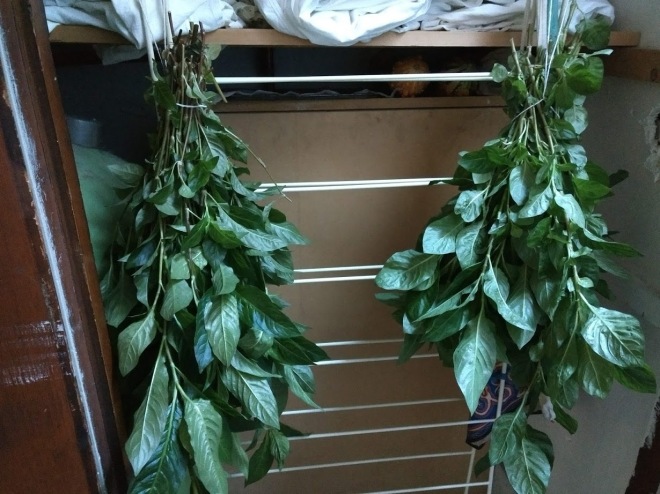Because we had such a long hot summer in the UK last year my homegrown Japanese indigo lasted well into the autumn, and I didn’t have time to use all the fresh leaves for dyeing.
I’m always reluctant to waste anything so at the end of the season I cut the remaining stems, tied them into bunches, and hung them in my airing cupboard to dry out. Quite a few of them had flowers on, so I snipped these off and dried them separately in a paper bag to save the seeds.
Within a few weeks the leaves had dried out and gone slightly blue (dried bunch on the right).
I stripped all the dried leaves off and stored them, hoping to find a method of making an indigo vat with dried leaves.
I then managed to acquire a copy of John Marshall’s excellent book Singing the Blues, which contains lots of ideas for using fresh indigo leaves, as well as a method of making a vat with dried leaves. Eureka!
John’s method involves heating the leaves with soda ash (alkali) and thiox (thiorea dioxide – reducing agent), but I didn’t really like the idea of heating thiox, which produces harmful vapours above 40ºC. So I decided to try making the vat with lime as the alkali and fructose as the reducing agent. This is how I make organic indigo vats, following Michel Garcia’s 123 recipe (1 part indigo, 2 parts lime, 3 parts fructose).
The problem, of course, is that I had no idea about the quantity of indigo contained in the leaves. It was at the end of the season, and some of the plants had flowered, so the level of indigo was likely to be low. When I extracted indigo from fresh leaves earlier last year, I obtained 4g of solid pigment from 215g of fresh leaves – but I don’t know how pure the indigo was.
Fresh leaves weigh more than dried leaves so I decided to assume 4g of indigo in my dried leaves, which was probably on the optimistic side!
Here’s what I did:
- I simmered my 104g of dried leaves in 5 litres of water for 20 minutes to remove impurities, strained the leaves and discarded the liquid.
- I simmered the same leaves in another 5 litres of water with 8g of lime and 12g of fructose for 20 minutes. John Marshall says a dark blue film should form on the surface, but I didn’t see this. The liquid was a very dark yellow. I strained it and kept the liquid anyway.
- I then repeated the previous step three times. The second time I got a little blue, but by the third and fourth times there was significantly more blue and even a little indigo “flower”.
- I combined the second, third and fourth extractions and decided to discard the first extraction, as it didn’t look as if it contained much indigo.
- I let the extractions cool down and then added a couple of pieces of cotton – one plain, one with shibori bindings. I left them for five minutes, wrung them out and hung them to oxidise.
- There was barely any colour at all after the first dip, so I repeated this three more times. The final result is shown below. The colour in the photos actually looks a bit darker than in real life.
So the technique does work. The pale colour is probably due to low indigo levels in the leaves at the end of the season.
It is quite time consuming, but may be a way of preserving indigo leaves for later use if you don’t have time to use them fresh or don’t have facilities for composting.









Hey! Not bad for such a small amount! I managed to save a paltry 4gr of leaves a few years ago. I just look at them, because i’m pretty sure there’s not enough to do *anything* with them, but look at them…. 🙂
Sometimes just looking at them is enough Arlee. 😉 I guess there isn’t much you can do with 4g of dried leaves. But if you do manage to grow your own despite your weather and don’t have enough to make into a vat you could always bash the leaves onto fabric or rub them over a stencil to create a pattern, as described by John Marshall in his book.
Fascinating reading Kim, but oh so time consuming! Where do you find it? You must be pleased that your efforts paid off.
Yes, it’s good to know that the technique works. And finding time is a question of priorities – so the indigo plants get watered but the house is full of cobwebs! 😉
Looks like a lot of effort but it’s good to have a variety of values/shades of blue!
Yes, it can be tricky to get very pale shades of blue from a vat rather than fresh indigo, so I should be grateful. 😉
Try this instead based on Michel Garcia’s adaptation for dried indigo. I just tried it with a 123 vat and it was disappointing. so this is next on my list of things to try. https://debmcclintock.me/2015/09/14/dried-leaf-japanese-indigo-process-take-1/
Thanks! Deb used the John Marshall method, which I refer to in the post. But as I said, I prefer not to heat thiox due to the fumes. I’m happy to use it in a normal indigo vat.
oops. Yes, you’re right. I meant to send you this instead –https://youtu.be/Mpg4EVJSiz0 Michel Garcia’s adaptation of his 123 vat. I agree about heating Thiox.. yuck. Sorry for the mixup!
Thanks – very interesting! And impressive colour from a relatively small number of leaves. 🙂
I thought so too. I haven’t tried it but will next week! Comes recommended though.